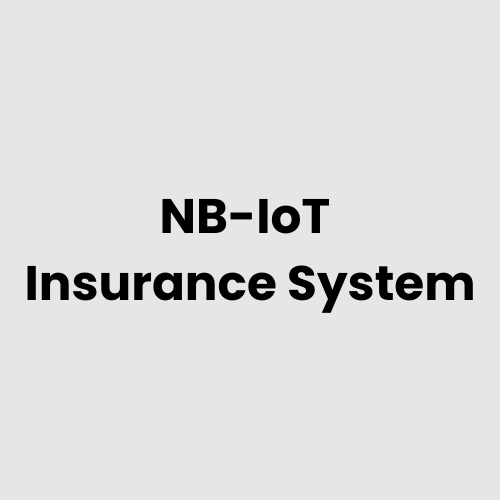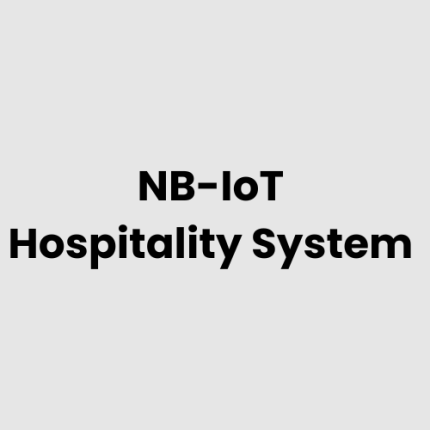Description
The NB-IoT Enabled Insurance IoT System is built to enhance the efficiency of insurance services through real-time data monitoring and analytics. The system integrates various components to offer end-to-end solutions for tracking, claims management, and fraud detection.
The architecture consists of three main layers:
- Sensor Layer: This layer includes IoT devices, such as smart sensors placed on insured assets (e.g., vehicles, homes, machinery) to collect data in real time. These sensors capture critical information such as temperature, motion, location, and other asset-specific parameters.
- Connectivity Layer: The NB-IoT network ensures seamless, low-power, wide-area communication for transmitting data from the sensors to the central system. The NB-IoT network guarantees reliable, secure, and cost-efficient communication even in remote or low-coverage areas.
- Data Management Layer: The data collected from the sensors is processed and analyzed on a centralized server or cloud platform. Machine learning models are utilized to detect patterns, assess risks, process claims, and generate insights. Additionally, data storage is secure and scalable to meet growing demands.
- Application Layer: This layer provides interfaces for the insurance company’s operations team to interact with the system. Applications such as dashboards, customer portals, and analytics tools help streamline claims processing, risk assessment, and customer service.
List of Hardware for NB-IoT Enabled Insurance IoT System
- NB-IoT Sensors: Devices capable of monitoring various conditions (e.g., temperature, motion, humidity) on insured assets.
- Gateways/Edge Devices: These devices act as intermediaries between the sensors and the cloud, collecting and transmitting data over NB-IoT networks.
- Server/Local Data Center: Servers for processing and storing the data, either hosted on-premise or through a cloud platform.
- Power Supply Systems: Low-power, energy-efficient systems to ensure the longevity of devices in remote areas.
- Routers/Modems: Connectivity devices for ensuring reliable NB-IoT signal reception in different locations.
Physical Placement Considerations of the Hardware
- Sensors: Devices should be placed in secure and strategic locations to monitor the insured assets effectively, such as vehicles, machinery, and homes.
- Gateways: Positioned to ensure maximum coverage and signal strength. This could include rooftop installations for urban environments or remote towers in rural areas.
- Servers/Data Centers: The processing server should be located in a secure data center or server farm to ensure uptime and scalability. This could be in-house or cloud-based depending on the deployment preference.
- Power Sources: Installations in remote or off-grid locations should utilize solar or battery-powered solutions to ensure continuous operation.
Hardware Architecture of NB-IoT Enabled Insurance IoT System
The system architecture follows a modular approach with the following components:
- End Devices (Sensors): These smart devices are installed on the assets being insured. They collect various environmental and situational data.
- Connectivity Devices (Gateways/Edge Devices): These devices aggregate the data from the sensors and forward it through the NB-IoT network.
- Local Servers or Cloud Platform: The data is processed, analyzed, and stored in these systems. The platform provides the necessary tools for data visualization and decision-making.
- User Interface: Dashboards, web applications, and mobile apps allow users (insurance companies, clients) to access and manage data.
Deployment Considerations for NB-IoT Enabled Insurance IoT System
- Network Coverage: NB-IoT is ideal for environments where traditional cellular coverage might be lacking. Ensure NB-IoT coverage is available or supplement with local gateway setups if required.
- Security: Robust encryption protocols should be implemented for data transmission. Ensure the system complies with insurance and data protection regulations such as GDPR and HIPAA.
- Scalability: The system must be able to scale as the number of monitored assets increases. Cloud-based solutions provide a flexible and cost-effective way to manage this scaling.
- Maintenance: Regular firmware updates and preventive maintenance for hardware are necessary to ensure long-term reliability.
List of Relevant Industry Standards and Regulations
- ISO 27001 (Information Security Management)
- GDPR (General Data Protection Regulation)
- HIPAA (Health Insurance Portability and Accountability Act)
- PCI-DSS (Payment Card Industry Data Security Standard)
- IEEE 802.15.4 (for low-power wireless communications)
- LoRaWAN Certification for low-power wide-area networks
- ITU-T Y.2222 (IoT requirements and standards)
Local Server Version of NB-IoT Enabled Insurance IoT System
In a local server deployment, the system is hosted entirely on-premise within an insurance company’s infrastructure. The local server would receive data directly from the IoT sensors and process it on-site, ensuring control over sensitive data and reducing dependence on external cloud providers. This version is ideal for businesses with strict data privacy requirements or those that require full control over their IT systems.
Cloud Integration and Data Management
Cloud integration enables the system to scale efficiently and provides real-time access to data from anywhere. Data management in the cloud allows for seamless storage, processing, and analysis, leveraging advanced analytics and machine learning algorithms. Insurance companies can use cloud-based systems to monitor assets in real time, process claims quickly, and improve overall service delivery. Additionally, the cloud provides the flexibility to store vast amounts of data, which can be retrieved and analyzed on-demand.
GAO Tek Inc. is committed to offering flexible, scalable, and secure solutions to meet the unique needs of the insurance industry. Our advanced NB-IoT-enabled solutions can streamline operations, enhance customer experiences, and improve risk management through data-driven insights.
GAO Case Studies of NB-IoT Enabled Insurance IoT System
USA Case Studies
- New York City, NY
An insurance provider implemented an NB-IoT-enabled system to track and monitor the condition of vehicles covered under their auto insurance policies. Using real-time data from sensors in vehicles, the system collects data on driving habits, weather conditions, and vehicle performance to offer more accurate pricing and prevent claims fraud. - Los Angeles, CA
In California, an insurance company leveraged NB-IoT-enabled sensors to monitor residential properties. The system tracks environmental factors such as temperature, humidity, and motion, allowing for immediate claims alerts in cases of water damage or fire, helping to expedite the claims process. - Chicago, IL
A health insurance firm used NB-IoT to monitor policyholders’ fitness devices and health metrics in real-time. This data is analyzed to offer personalized coverage plans and rewards for healthy living, improving customer retention and engagement through proactive health management. - Dallas, TX
An NB-IoT-enabledsolution was used by an insurance company in Dallas to track the conditions of industrial machinery covered under equipment breakdown insurance. By continuously monitoring operational parameters, the system can detect early signs of failure and notify both insurers and insureds before major issues arise. - Miami, FL
In Miami, an insurance provider adopted NB-IoTto monitor the integrity of high-value cargo during shipping. Sensors attached to containers track movement, temperature, and other conditions, ensuring that any potential damage during transport is immediately identified, enabling rapid claims processing. - San Francisco, CA
A large commercial insurer in San Francisco implemented an NB-IoT-based system to enhance its property insurance services. The system detects environmental factors like flooding or earthquakes in real-time and automatically triggers risk mitigation actions or alerts, improving response times and minimizing loss. - Boston, MA
In Boston, a home insurance provider deployed NB-IoT sensors to monitor homes for fire and water damage risks. The system proactively notifies homeowners and insurers of any issues, reducing response times and enabling insurers to adjust premiums based on real-time risk assessments. - Seattle, WA
An insurance company operating in Seattle utilized NB-IoT for the management of policies covering rental properties. By deploying sensors in residential units, the company monitors property conditions like temperature and occupancy to reduce the likelihood of claims due to vandalism or neglect. - Phoenix, AZ
An insurance company in Phoenix employed an NB-IoT-enabled system to monitor agricultural assets, such as irrigation systems and farm equipment. This system provides real-time alerts for equipment malfunctions or environmental factors, improving risk management and insurance claims response times for farmers. - Denver, CO
In Denver, NB-IoT sensors were used in an insurance solution to monitor the performance of HVAC systems in commercial properties. This data is used to assess risk factors, predict failures, and offer discounts for well-maintained systems, benefiting both insurers and property owners. - Atlanta, GA
An insurer in Atlanta adopted NB-IoT-enabled sensors to track the conditions of insured vehicles, focusing on real-time data collection for accident detection. This allows for faster claim resolution and encourages safer driving behavior through data-driven risk assessments. - Las Vegas, NV
NB-IoT sensors were deployed in Las Vegas by an insurance company to track conditions of hotels and casinos. These sensors monitor the status of electrical systems, HVAC, and other critical infrastructure, enabling immediate intervention in case of system failures, thus preventing large-scale losses. - Washington, D.C.
In Washington, D.C., an insurance company used NB-IoT to track and monitor the energy usage of commercial properties, allowing them to offer green insurance policies. Data gathered from energy consumption helps insurers tailor premiums and encourage sustainable business practices. - Houston, TX
In Houston, an oil and gas insurance company integrated NB-IoT technology to monitor offshore drilling operations. The system tracks equipment status, environmental conditions, and safety factors, providing continuous risk assessment data and improving response time in case of emergencies or equipment failures. - Salt Lake City, UT
A major health insurer in Salt Lake City utilized NB-IoT to monitor wellness devices worn by policyholders. These devices track physical activity, heart rate, and other health metrics, helping insurers offer tailored health plans and incentives for maintaining a healthy lifestyle, thereby reducing overall claims. - Toronto, ON
In Toronto, a Canadian insurance company used NB-IoT sensors to monitor home properties for early signs of potential damage, such as water leaks or structural shifts. The system automatically triggers alerts, helping insurers prevent costly claims and reducing insurance premiums for homeowners with smart devices. - Vancouver, BC
An NB-IoT-enabled solution was deployed by an insurer in Vancouver to monitor commercial buildings for fire, gas leaks, and other safety hazards. The real-time monitoring and early warning system reduced potential claims and offered more accurate premium calculations based on live risk data.
Navigation Menu for NB-IoT
Navigation Menu for IoT
- LORAWAN
- Wi-Fi HaLow
- Z-WAVE
- BLE & RFID
- NB-IOT
- CELLULAR IOT
- GPS IOT
- IOT SENSORS
- EDGE COMPUTING
- IOT SYSTEMS
Our products are in stock and can be shipped anywhere in the continental U.S. or Canada from our local warehouse. For any further information, please fill out this form or email us.
We are actively looking for partners who are like us located in the U.S. and Canada. For more information on partnering with GAO, please visit Partner with GAO Tek Inc.It lists various ways to partner with GAO, such as OEM Partnerships, Technology Integration, Distribution and Reselling Opportunities, Presenting at the Leading Event Tek Summit, Joint R&D Projects, Training and Consulting Services, Industry-Specific Collaborations, Research and Academic Partnerships.



